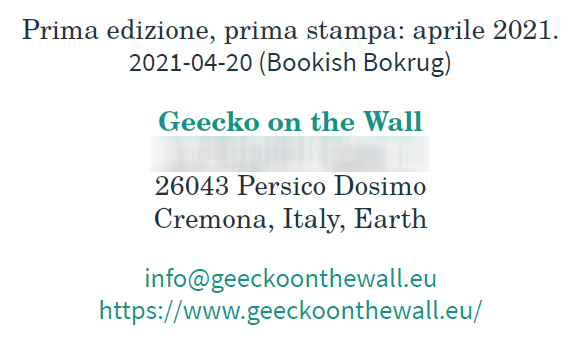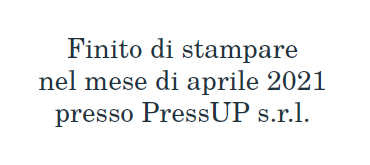Printing information | Indicazioni di stampa
🇬🇧
Small warning: in this tutorial, I will talk about the reality of small independent self-published authors in Italy. When I talk about the law, I refer to the Italian one: I don’t know how things work in other legal systems. I will also talk about my printer, which was PressUP: I don’t know how it works with other printers.
Italian law provides that the work must obligatorily bear certain information. I quote law 47 of 8 February 1948, article 2, concerning the “Compulsory indications on the printed matter”:
Every printed work must indicate the place and year of publication, as well as the name and address of the printer and, if there is one, of the publisher.
Who is the publisher?
Let’s get a few things straight: an independent game designer is, in fact, both the author and the publisher of his own work.
I have done some research and it seems to me that no law specifies what you have to do to be recognised as a publisher or to become one. If we believe the AIE (Italian Publishers Association), which is “only” a trade association, publishers are those who provide:
with continuous activity the publication on their own account and at their own expense of original works in the form of books, magazines and electronic and multimedia publishing products.
Another site, FiscoOggi, gives another definition, which is very interesting, and which I share:
The publisher is the one who assumes the business risk of marketing the publishing product.
In short, on a moral and ontological level, if you self-publish, you are the publisher of your work. On a legal, or at least formal, level, however, I understand that you should constitute yourself as a publisher, but the law does not specify how to do this. One important thing to note, however, is that to be a publisher you do not necessarily have to be a member of the AIE.
Publisher’s address
But back to us. Does this mean that, if we self-publish, we have to put our home address in our work, since we are publishers of ourselves? I don’t really have the expertise to answer that, but I understand that doing so is essentially correct. However, since we are not formally publishers, the law itself seems to me to leave us the discretion to decide whether or not to do so (that “if any” says a lot!). My decision with Creating Good Investigators, for example, was to do so. But I could also have not done it.

Place and date of publication
Another very important thing is that the work must state the date and place of publication. For the date, it is sufficient to indicate the year, but I see that many people also indicate the month. For the place, however, there is no escaping it: if there were a publisher, it would be one of its registered offices but, for an independent author, it means indicating your municipality of residence or domicile.
This is unless you are “publishing” the work at a given event. For example, if I make a presentation in Cremona and from that moment I sell or distribute the work, I could put “Cremona” as the place of publication. The same would apply if I were making the work public, for example, at an event held in Lucca. In that case, I could indicate “Lucca” as the place of publication. In other words, either put the place where you are presenting and publishing the work for the first time, or your municipality of residence or domicile, which counts as the place of publication in the absence of other specifics.
Generally, all this information should be given in the colophon of the book, which is the even-numbered page before the title page (which should always be on an odd-numbered page). However, you can also state the place and date of publication on the title page, usually just above or below the publisher’s name, as was already done in incunabula and 16th century printed books (and, therefore, always).
Printer’s address
There is no getting away from this either: it must be indicated. Usually, I see it indicated on the last even-numbered page of the book, at the bottom, but sometimes I find this indication on the colophon. I advise you to put it where you prefer, trying to use unnecessary pages, if you can (and therefore to consume more paper: poor trees!). However, you should also take into account that, in publishing, we always think in quarters, that is, from four to four pages, so sometimes you may have blank pages “to be filled”.
In this case, the indication I see most often is:
Finished printing
in ⟨month⟩ ⟨year⟩
at ⟨printer’s name⟩
⟨address of domicile⟩
As for Creating Good Investigators, I had also put in the factory address, but PressUP asked me to remove it. I took care of it like a good little soldier, but I suspect this is illegal (on the other hand, the law is clear). In any case, the printer is easily traceable on the internet, so I think the substantiality of the printer’s indication is respected.
So, in the end, my printing indication looked like this:

Finished printing
in April 2021
at PressUP s.r.l.
By now it’s too late, but then I thought I could put the printer’s web address.
There, we have reached the end of this article-tutorial. I hope that this information and the insight into my experience that I have shared with you will be useful.
🇮🇹
Piccola avvertenza: in questo tutorial, parlerò della realtà dei piccoli autori indipendenti che si autopubblicano in Italia. Quando parlo delle legge, mi riferisco a quella italiana: non so come funzionino le cose negli altri ordinamenti giuridici. Parlerò anche del mio stampatore, che è stato PressUP: non so come funzioni con gli altri stampatori.
La legge italiana prevede che l’opera debba obbligatoriamente recare alcune informazioni. Cito la legge 47 dell’8 febbraio 1948, all’articolo 2, concernente le “Indicazioni obbligatorie sugli stampati”:
Ogni stampato deve indicare il luogo e l’anno della pubblicazione, nonché il nome e il domicilio dello stampatore e, se esiste, dell’editore.
Chi è l’editore?
Chiariamo alcune cose: un ideatore indipendente di giochi è, di fatto, sia l’autore sia l’editore della propria opera.
Ho fatto qualche ricerca e mi pare di capire che non vi sia nessuna legge che precisa cosa occorra fare per essere riconosciuti come editori o per costituirsi come tali. Se prestiamo fede all’AIE (Associazione Italiana Editori), che tuttavia è “solo” un’associazione di categoria, sono editori coloro che provvedono:
con attività continuativa alla pubblicazione per proprio conto e a proprie spese di opere dell’ingegno in forma di libri, riviste e prodotti dell’editoria elettronica e multimediale.
Un altro sito, FiscoOggi, dà un’altra definizione, molto interessante, e che mi sento di condividere:
L’editore è colui che assume il rischio d’impresa della commercializzazione del prodotto editoriale.
Insomma, a livello morale e ontologico, se vi autopubblicate, siete proprio voi gli editori della vostra opera. A livello giuridico o, perlomeno, formale, invece, mi pare di capire che dovreste costituirvi come editori, ma la legge non precisa come farlo. Una cosa importante da notare, comunque, è che per essere editori non bisogna essere necessariamente iscritti all’AIE.
Indirizzo dell’editore
Ma torniamo a noi. Questo significa che, se ci autopubblichiamo, dobbiamo mettere l’indirizzo del nostro domicilio nella nostra opera, siccome siamo editori di noi stessi? Non ho davvero la competenza per rispondere, ma mi pare di capire che farlo sia sostanzialmente corretto. Tuttavia, non essendo noi formalmente degli editori, la legge stessa mi sembra che ci lasci la discrezionalità di decidere se farlo o meno (quel «se esiste» la dice lunga!). La mia decisione con Creare buoni Investigatori, per esempio, è stata quella di farlo, ma avrei anche potuto non farlo.

Luogo e data di pubblicazione
Un’altra cosa molto importante è che l’opera deve riportare la data e il luogo di pubblicazione. Per la data è sufficiente indicare l’anno, ma vedo che molti indicano anche il mese. Per il luogo, invece, non ci si scappa: se ci fosse un editore, sarebbe quello della sua sede legale ma, per un autore indipendente, significa indicare il proprio comune di residenza o di domicilio.
Questo a meno che non stiate “pubblicando” l’opera in un dato evento. Per esempio, se faccio una presentazione a Cremona e da quel momento vendo o distribuisco l’opera, potrei mettere come luogo di pubblicazione “Cremona”. Lo stesso varrebbe se stessi rendendo pubblica l’opera, per esempio, a un evento che si tiene a Lucca. In quel caso potrei indicare “Lucca” come luogo di pubblicazione. Insomma, o mettete il luogo dove state presentando e pubblicando l’opera per la prima volta, oppure il vostro comune di residenza o domicilio, che conta come luogo di pubblicazione in mancanza di altre specificità.
In genere, tutte queste informazioni devono essere riportate nel colophon del libro, che è la pagina di numerazione pari che precede il frontespizio (che deve sempre essere su pagina dispari). Potete comunque riportare il luogo e la data di pubblicazione anche nel frontespizio, generalmente appena sopra o sotto il nome dell’editore, come già si faceva negli incunabuli e nelle cinquecentine (e, quindi, da sempre).
Indirizzo dello stampatore
Anche su questo non si scappa: va indicato. Di solito, vedo che si indica nell’ultima pagina a numerazione pari del libro, in basso, ma talvolta trovo questa indicazione sul colophon. Vi consiglio di metterla dove preferite tra il colophon e l’ultima pagina pari, cercando di usare pagine inutili, se potete (e quindi di consumare meno carta: poveri alberi!). Però, tenete anche conto che, in editoria, si ragiona sempre per quarti, ossia di quattro in quattro pagine, per cui potreste facilmente avere delle pagine bianche “da riempire”.
In questo caso, l’indicazione che vedo più spesso è:
Finito di stampare
nel mese di ⟨mese⟩ ⟨anno⟩
presso ⟨nome dello stampatore⟩
⟨indirizzo del domicilio⟩
Per quanto riguarda Creare buoni Investigatori, avevo messo anche l’indirizzo dello stabilimento, ma PressUP mi ha chiesto di rimuoverlo. Ho provveduto come un bravo soldatino, ma ho il sospetto che questa cosa sia illegale (d’altra parte, la legge è chiara). In ogni caso, lo stampatore è facilmente rintracciabile su internet, per cui credo che la sostanzialità dell’indicazione dello stampatore sia rispettata.
Quindi, alla fine, la mia indicazione di stampa era così:

Finito di stampare
nel mese di aprile 2021
presso PressUP s.r.l.
Ormai è troppo tardi, ma poi ho pensato che avrei potuto comunque mettere l’indirizzo web dello stampatore.
Ecco, siamo arrivati alla fine di questo articolo-tutorial. Spero che queste informazioni e scorcio sulla mia esperienza che vi ho mostrato possano esservi utili.
Get Creating Good Investigators | Creare buoni Investigatori
Creating Good Investigators | Creare buoni Investigatori
A fan-made expansion for Cthulhu Dark
| Status | Released |
| Category | Physical game |
| Author | Geecko on the Wall |
| Tags | cthulhu-dark |
| Languages | English, Italian |
More posts
- FSC certification | Certificazione FSCMay 11, 2021
- Prints have arrived | Le stampe sono arrivateMay 01, 2021
- Version 2021-04-20 (Bookish Bokrug)Apr 20, 2021
- Practical guide to mistakes | Guida pratica agli erroriApr 19, 2021
- Goal achieved | Obiettivo raggiuntoApr 19, 2021
- How to print your booklet | Come stampare il tuo manualettoApr 18, 2021
- Proofreading | Correzione delle bozzeApr 17, 2021
- Version 2021-04-12 (Abhorrent Abhoth)Apr 12, 2021
Leave a comment
Log in with itch.io to leave a comment.